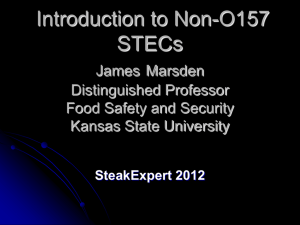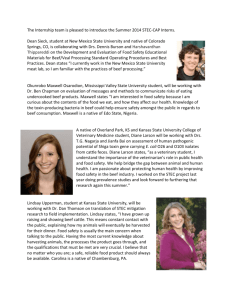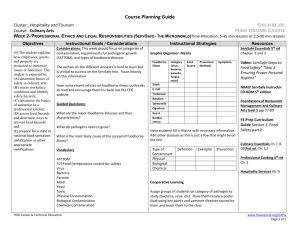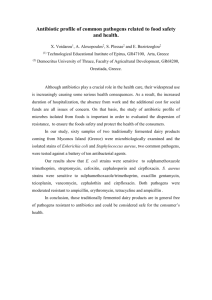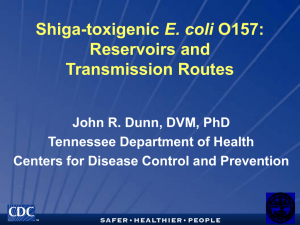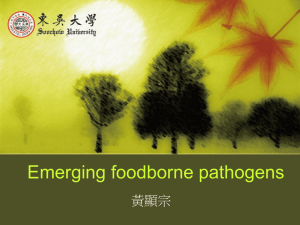It's Time to Move on non-O157:H7 STECs May 02, 2011
advertisement
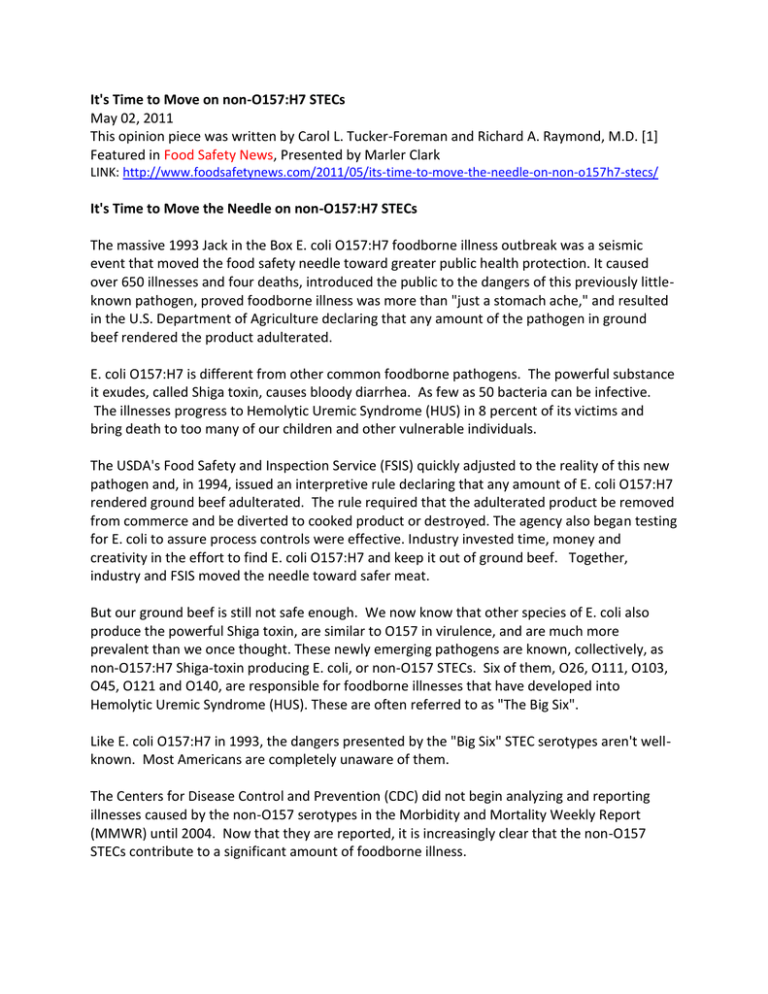
It's Time to Move on non-O157:H7 STECs May 02, 2011 This opinion piece was written by Carol L. Tucker-Foreman and Richard A. Raymond, M.D. [1] Featured in Food Safety News, Presented by Marler Clark LINK: http://www.foodsafetynews.com/2011/05/its-time-to-move-the-needle-on-non-o157h7-stecs/ It's Time to Move the Needle on non-O157:H7 STECs The massive 1993 Jack in the Box E. coli O157:H7 foodborne illness outbreak was a seismic event that moved the food safety needle toward greater public health protection. It caused over 650 illnesses and four deaths, introduced the public to the dangers of this previously littleknown pathogen, proved foodborne illness was more than "just a stomach ache," and resulted in the U.S. Department of Agriculture declaring that any amount of the pathogen in ground beef rendered the product adulterated. E. coli O157:H7 is different from other common foodborne pathogens. The powerful substance it exudes, called Shiga toxin, causes bloody diarrhea. As few as 50 bacteria can be infective. The illnesses progress to Hemolytic Uremic Syndrome (HUS) in 8 percent of its victims and bring death to too many of our children and other vulnerable individuals. The USDA's Food Safety and Inspection Service (FSIS) quickly adjusted to the reality of this new pathogen and, in 1994, issued an interpretive rule declaring that any amount of E. coli O157:H7 rendered ground beef adulterated. The rule required that the adulterated product be removed from commerce and be diverted to cooked product or destroyed. The agency also began testing for E. coli to assure process controls were effective. Industry invested time, money and creativity in the effort to find E. coli O157:H7 and keep it out of ground beef. Together, industry and FSIS moved the needle toward safer meat. But our ground beef is still not safe enough. We now know that other species of E. coli also produce the powerful Shiga toxin, are similar to O157 in virulence, and are much more prevalent than we once thought. These newly emerging pathogens are known, collectively, as non-O157:H7 Shiga-toxin producing E. coli, or non-O157 STECs. Six of them, O26, O111, O103, O45, O121 and O140, are responsible for foodborne illnesses that have developed into Hemolytic Uremic Syndrome (HUS). These are often referred to as "The Big Six". Like E. coli O157:H7 in 1993, the dangers presented by the "Big Six" STEC serotypes aren't wellknown. Most Americans are completely unaware of them. The Centers for Disease Control and Prevention (CDC) did not begin analyzing and reporting illnesses caused by the non-O157 serotypes in the Morbidity and Mortality Weekly Report (MMWR) until 2004. Now that they are reported, it is increasingly clear that the non-O157 STECs contribute to a significant amount of foodborne illness. The non-O157 STECs may be new and emerging pathogens, but it is also possible that they've been out there for years, causing people to get sick and die but were invisible because no scientists or laboratories were looking for them. What we do know now is that the CDC's annual reports on the incidence of foodborne illness in the U.S., published in the Mortality and Morbidity Monthly Report (MMWR), reveal an increase in non-O157 STEC illnesses in nearly every year from 2000 thru 2007, as follows : INCREASE IN REPORTED CASES OF NON-O157 STECs (2) Year Number of illnesses Rate of Illnesses per 100,000 population 2000 51 0.12 2004 106 0.23 2006 209 0.46 2007 260 0.57 The CDC report numbers reflect only the FoodNet catchment areas that represent 15 percent of the U.S. population. The total number of documented cases across the country is larger. Unfortunately, the CDC estimates that, even now, fewer than 10 percent of laboratories test for these pathogens. As a result, most of the illnesses continue to go unrecognized. It's unlikely that the number of cases of non-O157 STECs will decline if there is no organized program to prevent and control them. After Jack in the Box, we often referred to E. coli O157:H7 as "the rare but virulent" pathogen but once laboratories were required to test for it we found it was not so rare. Still, many people, including author and attorney Shawn Stevens, have the misconception that non-O157 STEC illnesses are uncommon. He wrote recently in Meatingplace.com that the "other non-O157 strains such as O111 and O145 which, though rare, (emphasis added) can ... cause illness" [3] The evidence shows these pathogens are far more common and cause more illness than previously recognized. The January 2011 CDC report updating data on foodborne illness in the U.S. illustrates that public perceptions lag behind reality. The annual case rate for E. coli O157:H7 is 63,000 and for Listeria Monocytogenes, it is 1,591. Both of these are far lower than the so-called rare non-O157 STECS that cause 113,000 cases of foodborne illness each year. [4] The most recent CDC FoodNet Report for the year 2009 reveals that, at several of the FoodNet sites, non-O157 STECs are found to cause illnesses more frequently than the declared adulterant E. coli O157:H7. [5] The rate of foodborne illnesses caused by non-O157 STECs and O157 is now about the same in children less than 4 years of age, perhaps our most vulnerable population. These are nasty pathogens, not to be taken lightly. And they are not rare. In 2007, USDA's Undersecretary for Food Safety was informed that some state public health labs were seeing as many non-O157 STEC infections as they were O157 illnesses. In response, FSIS, along with FDA and CDC, held a day-long information gathering session on the importance of non-O157 STECs and the public's health. During that meeting, it became clear that two hurdles prevented FSIS from moving forward: the agency had no solid numbers on the rate of non-O157:H7 STECs contaminating ground beef and commercially available tests for these pathogens were not yet fully developed. After this revelation, the FSIS immediately began joint efforts with the USDA's Agricultural Research Service to speed the development of consistent and convenient testing methodologies for non-O157 STECs. The two agencies recently completed test development and testing kits and protocols are available for all of the Big Six non-O157 STECs. They were preparing to move the needle toward more public health protection. Soon after the 2007 meeting, FSIS began testing ground beef for non-O157 contamination, but the agency has not made the results public. However, Dr. Mansour Samadpour of IEH Laboratories and Consulting Group in Seattle reported at the "7th International Symposium on Shiga Toxin Producing E. coli" that his lab tested approximately 5,000 samples of ground beef purchased at retail stores and found nonO157 STECs in 1.9 percent of the samples. One positive out of every 50 packages sampled suggests a high rate of contamination. It is more proof that the pathogens exist in our food supply and make people sick. The USDA Meat Animal Research Center, located in Clay Center, NE, has also done extensive testing not only for non-O157 STECs in ground beef but also on the relative virulence of the serotypes found. Their most recent research results, published in March, 2011, can be found at: www.ncbi.nlm.nih.gov/pubmed/21257806. We expected that, with the completion of the research and development work, the agency would be ready to move quickly to declare these pathogens to be adulterants and to begin testing for them, but there has been no further action. We were encouraged in our belief by President Obama's March 14, 2009 speech in which he pledged new attitudes and policies to address weaknesses in the national food safety system. "...there are certain things that we can't do on our own," he said. "There are certain things only a government can do. And one of those things is ensuring that the foods we eat, and the medicines we take are safe and don't cause us harm. The FSIS acted to carry out the President's pledge. It prepared a rule declaring non-O157 STECs adulterants in ground beef and requiring testing for them. We're confident that the kind of preventive action proposed by FSIS is far better than waiting until problem with non-O157 STEC foodborne illness reaches seismic proportions, like another Jack in the Box. The truth is that, if you don't look for these pathogens, you will not find them until after they've already made people sick. The numbers cited earlier indicate at least the potential for another seismic event, a large outbreak and needless illnesses and deaths. The difference now, as compared to 1993, is that we are forewarned. However, the FSIS's effort to follow through on the President's pledge has not been approved by the White House Office of Management and Budget. It is opposed by the American Meat Institute and some of our trading partners. In the case of AMI, its position is consistent with its opposition to declaring E. coli O157:H7 an adulterant. The AMI strongly opposed testing for O157 when it began and now opposes requiring meat companies to test for the "Big Six" nonO157 STECs. Some foreign countries may be concerned because, while they haven't found much E. coli O157:H7 in ground beef and trim, they have had occasional findings of non-O157 STECs. We think it is just good sense for anyone who has an interest in promoting the sale and use of ground beef to do everything possible to assure that it is free of pathogens, especially the virulent Shigatoxin producing E. coli serotypes. Anyone who opposes using every tool available to fight these virulent pathogens should try explaining their position of opposition to the parents of a child suffering kidney failure after contracting HUS from one of those strains of E. coli, or to the family of a Korean War veteran who lost their father to the poisoning. There are real people whose lives have been tragically altered by the presence of virulent pathogens in meat that bears the USDA seal of inspection. These pathogens are considered adulterants as defined by the Federal Meat Inspection Act. Currently, the U.S. government is not meeting either the letter of the law nor the societal expectation that our food will not make us sick. We urge the President, his appointees and the industry to join us in supporting FSIS's efforts to get non-O157 STECs out of our ground beef. -------------------------------[1] Carol L. Tucker-Foreman was USDA Assistant Secretary for Food and Consumer Services, 1977-81. Her responsibilities included the Food Safety and Inspection Service, the Food and Nutrition Service and elements of the Agricultural Marketing Service. Richard A. Raymond, M.D., was USDA Undersecretary for Food Safety, 2005-2008. [2] CDC. 2010. Preliminary FoodNet Data on the Incidence of Infection with Pathogens Transmitted Commonly Through Food -- 10 States, 2009 Report. Mortality and Morbidity Weekly Report (MMWR). Ap 16;59(14) 418-422. Accessed at www.cdc.gov/foodnet/reports.htm [3] April 4, 2011, Meatingplace.com blog Accessed at www.meatingplace.com/MembersOnly/blog/BlogDetail.aspx?blogID=37 [4] Scallon, et al. 2011. Foodborne Illness acquired in the U.S.--major pathogens.Emerging Infectious Disease [5] CDC Ibid.
